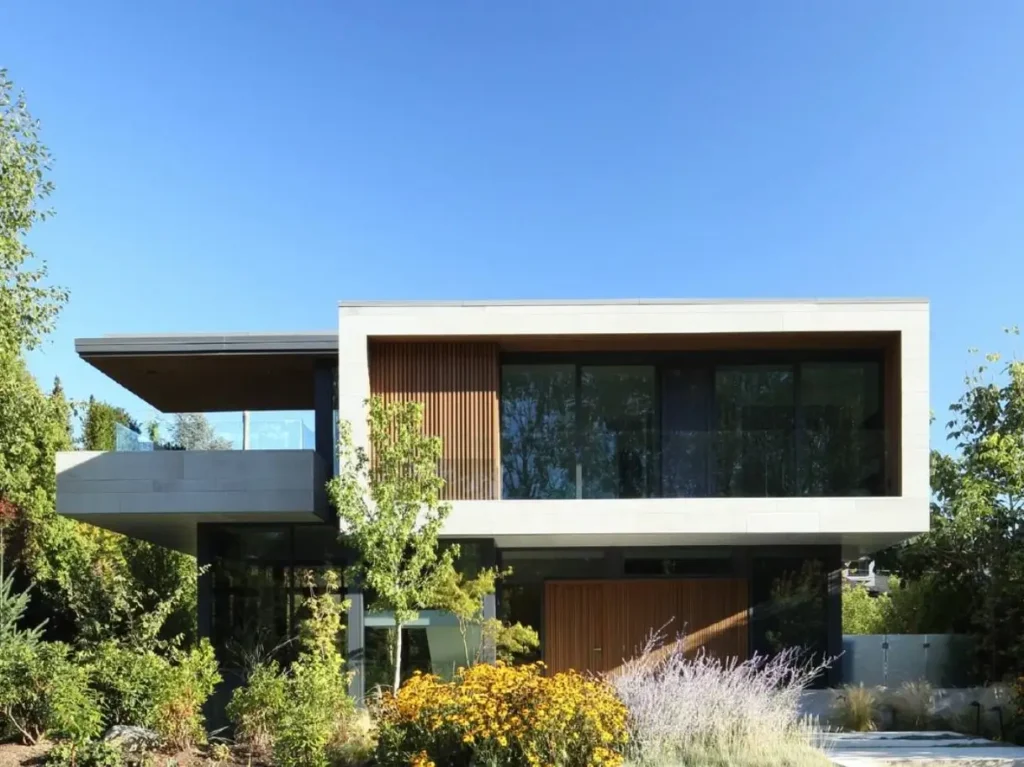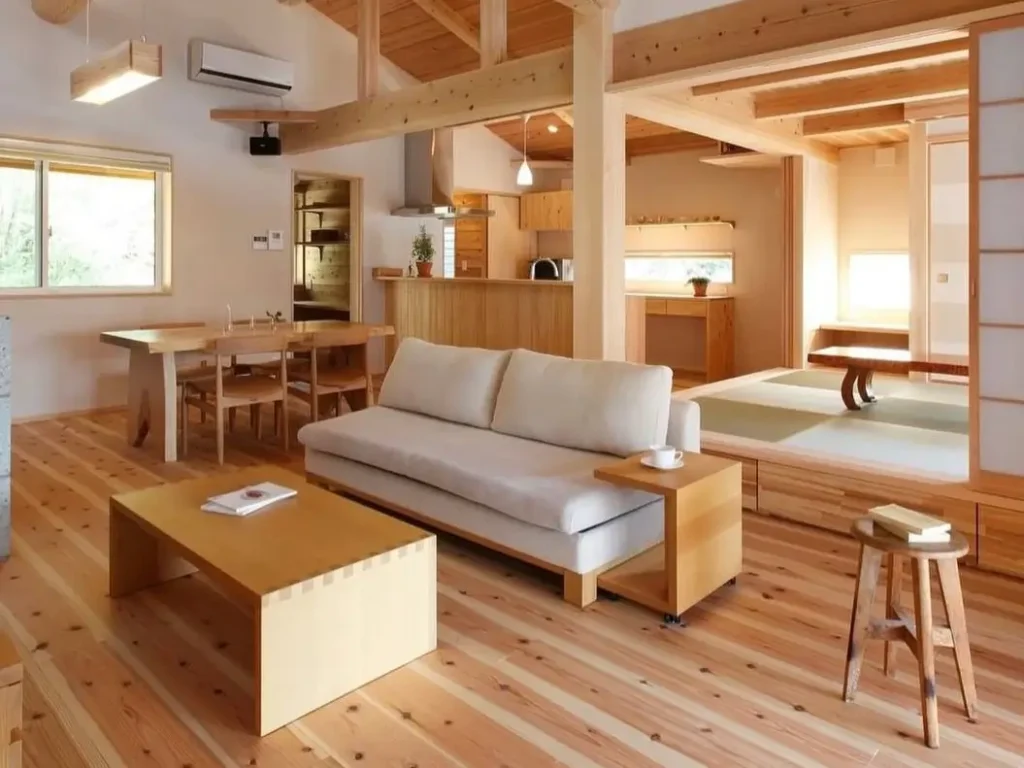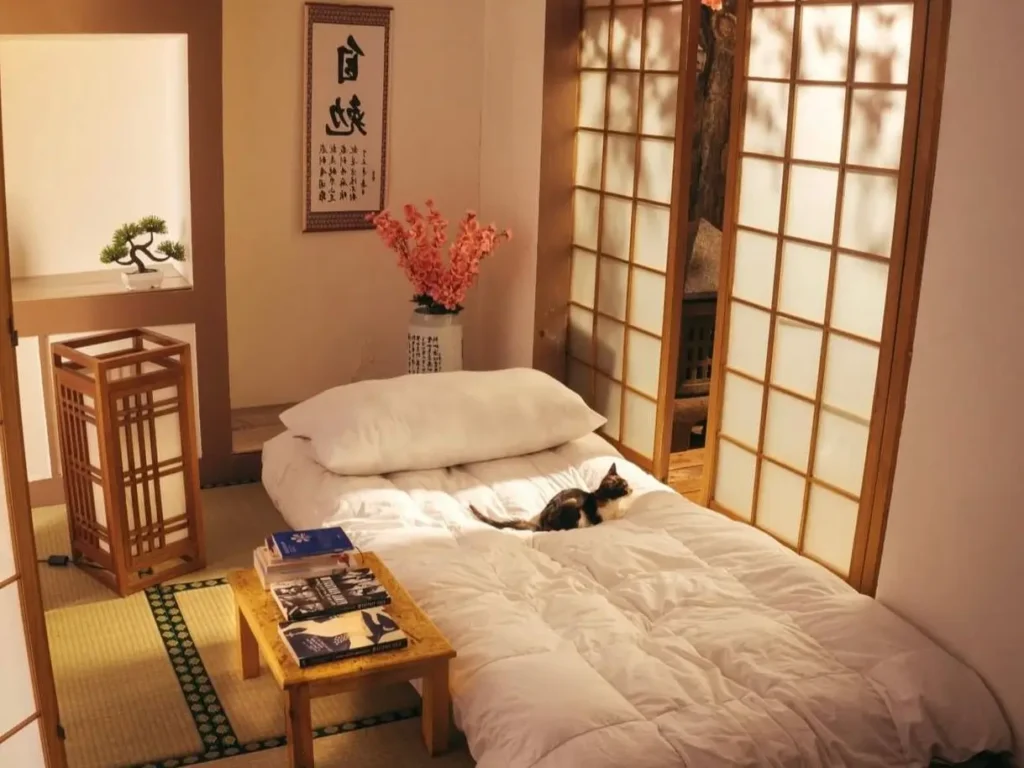The modern Scandinavian house exterior is an exercise in thoughtful restraint, emphasizing clean lines, natural materials, and a deep connection to the surrounding landscape. This design philosophy creates a welcoming and uncluttered first impression that feels both modern and deeply rooted in nature. At its best, a Scandinavian style home exterior showcases a masterful use of materials—from warm wood cladding to sleek metal roofs—all designed around expansive windows that invite the outside in.
Whether you’re planning a new build, a renovation, or simply love the minimalist facade of a modern Scandinavian exterior, finding the right inspiration is key. To guide you, we’ve analyzed countless designs to curate this definitive collection of 54 homes. Each one has been selected to showcase the blend of minimalism, warmth, and harmony that makes this enduring style so compelling.

Hallmarks of a Modern Scandinavian Exterior
At its heart, Nordic design is about simplicity, functionality, and a love for natural light and materials. This section explores the foundational shapes, lines, and core principles that define the quintessential modern Scandinavian house exterior.
1. Mix Wood and Metal

Light-toned vertical wood siding pairs beautifully with a durable metal roof, a hallmark of the modern Scandinavian house exterior. This combination offers both aesthetic warmth and resilience against the elements. Expansive glass walls at the gable end further connect the interior with the serene, natural surroundings.
2. Use an A-Frame Roof

A classic A-frame silhouette gets a contemporary update in this Scandinavian style home exterior. The steep roofline, clad in the same light-toned wood as the walls, extends to create a sheltered entryway, blending form and function seamlessly while enhancing the home’s clean architectural lines.
3. Install a Window Wall
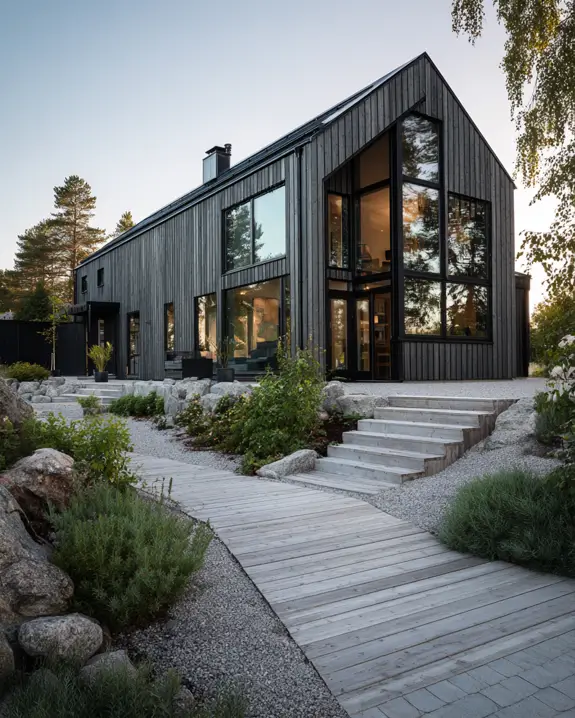
Expansive window walls are a defining feature of the modern Scandinavian house exterior, dissolving the boundary between inside and out. This design choice not only floods the home with natural light across multiple levels but also turns the surrounding landscape into a living piece of art.
4. Create a Grand Entrance

A deeply recessed entrance creates a grand sense of arrival and provides shelter from the elements. This exterior is defined by its continuous vertical wood cladding that wraps around the geometric volumes, guiding the eye towards the welcoming, glass-fronted entryway and its wide steps.
5. Update a Classic Silhouette
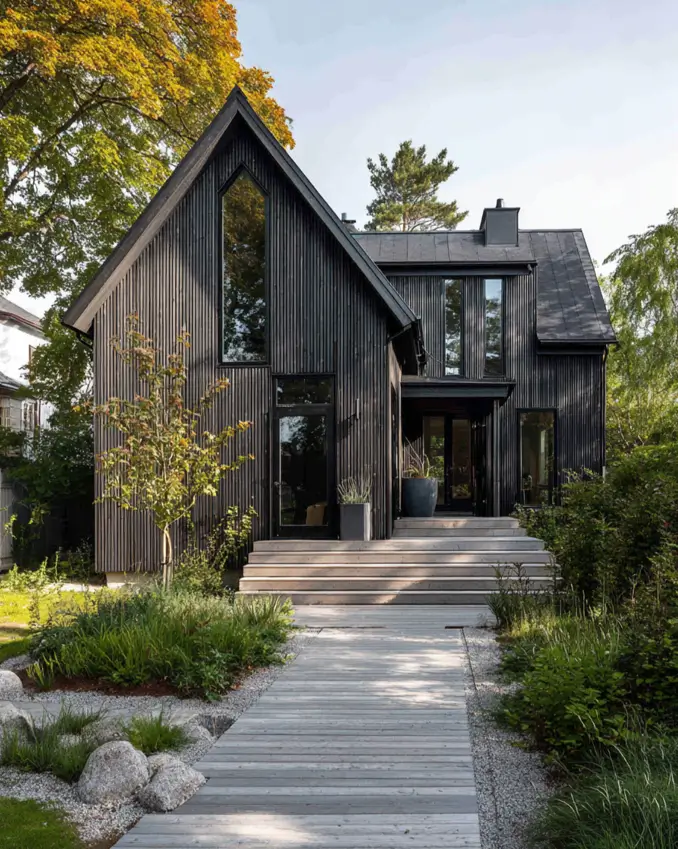
Dark vertical siding gives a traditional barn shape a distinctly modern and sophisticated update. This exterior features a tall, arched window that echoes the gable’s peak, adding an elegant touch and flooding the entryway with natural light.
6. Keep it Minimal
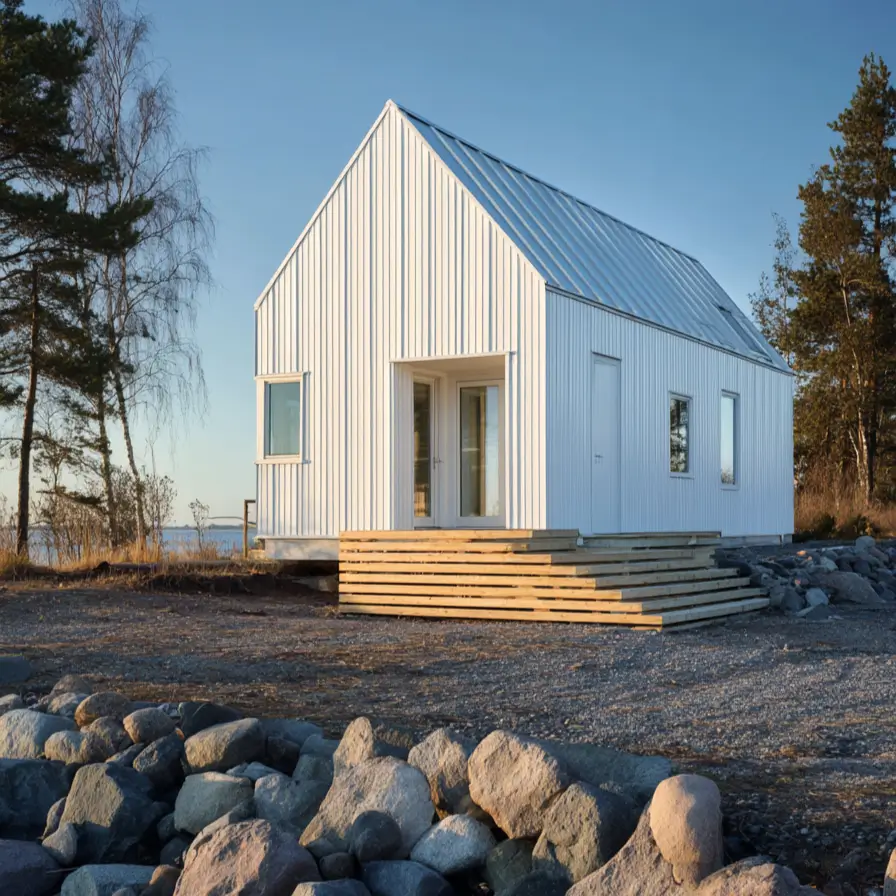
Pristine white vertical siding and a simple gable roof create a look of pure, uncluttered simplicity. This exterior strips the design down to its essentials, focusing on clean lines and a strong connection to its rugged coastal landscape.
7. Use Strategic Lighting

Strategic exterior lighting accentuates the home’s architectural lines against the evening sky. For this Scandinavian style home exterior, warm light from the expansive glass gable creates a welcoming beacon, while subtle uplighting on the siding adds depth and highlights the minimalist form after sunset.
Harmony with Nature: Landscape-Focused Designs
A defining characteristic of Scandinavian architecture is its deep respect for the natural world. These homes are designed to blend seamlessly with their surroundings, embodying the indoor-outdoor living concept through sustainable features and materials that echo the landscape.
8. Add a Green Roof
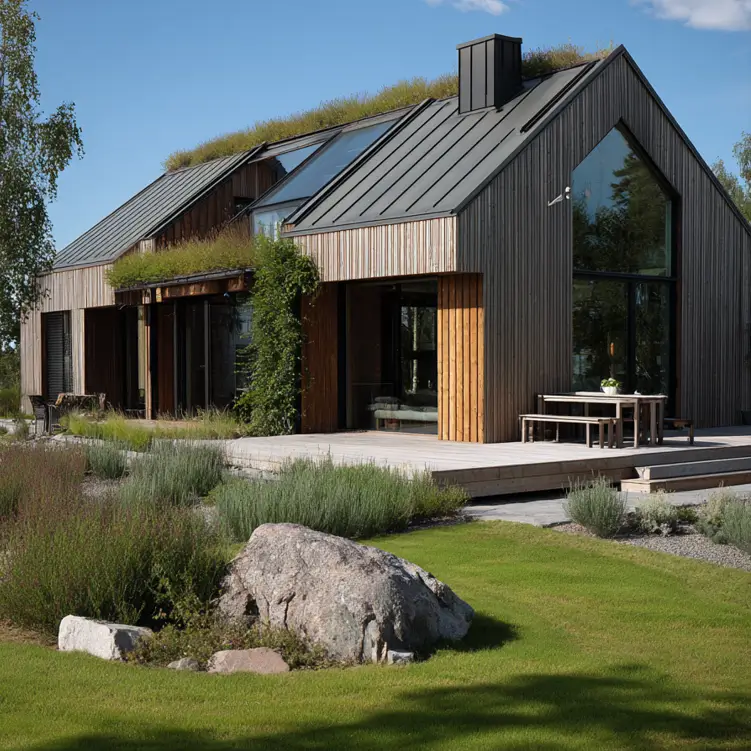
Living green roofs seamlessly integrate a home into its natural surroundings, a core tenet of Scandinavian design. This sustainable feature, a key element in sustainable home design, provides excellent insulation and creates a lush, elevated garden, blurring the line between the built environment and the landscape itself.
9. Design for Outdoor Living
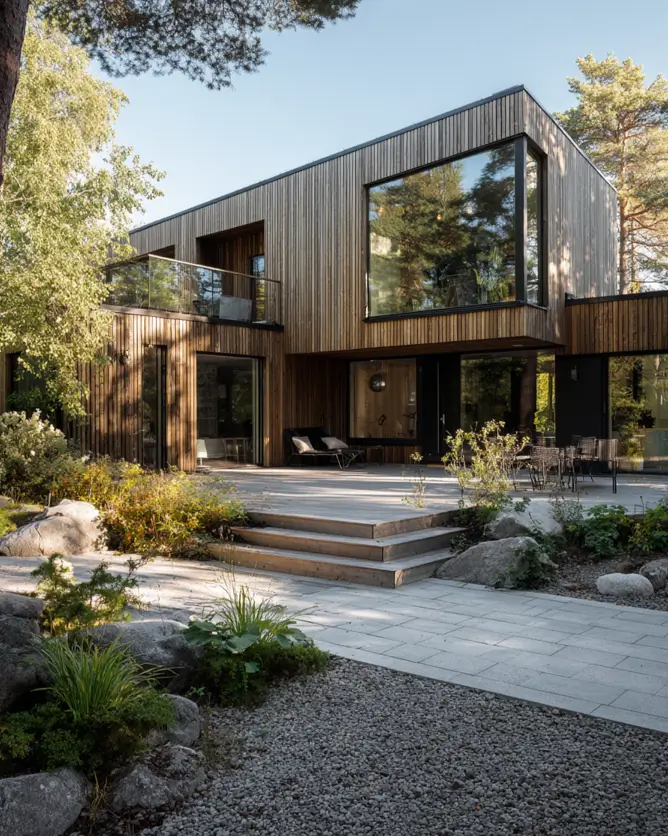
Expansive wooden decking creates a seamless transition from the home’s interior to the surrounding landscape. Large glass doors and picture windows on both levels further dissolve the barrier, making the garden and patio feel like a natural extension of the living spaces.
10. Build into the Landscape
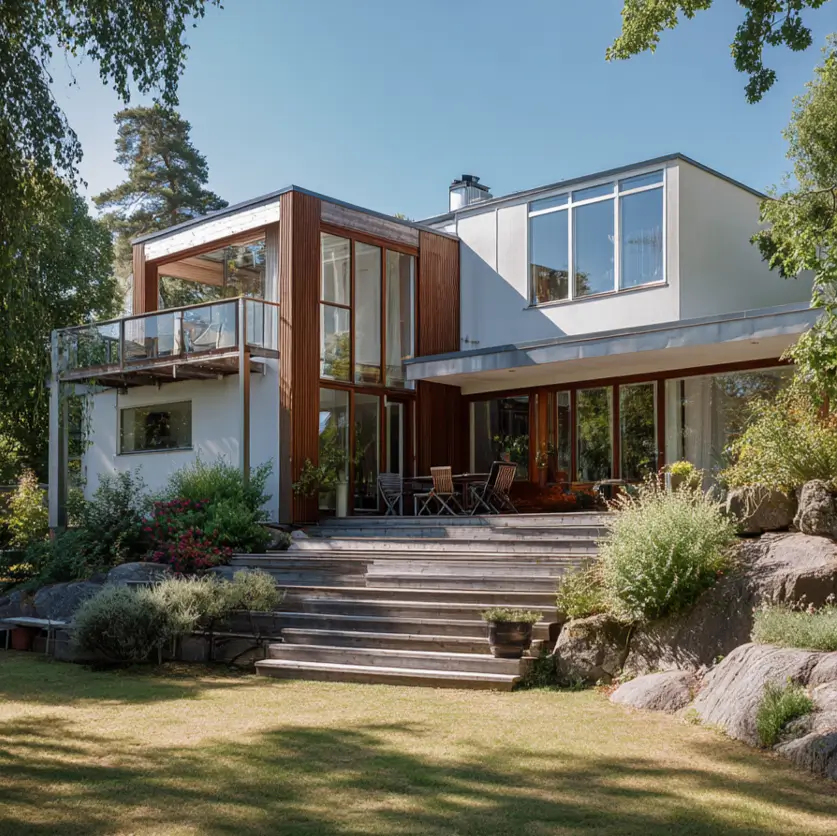
Building directly into a natural slope allows the home to merge with its environment. This Nordic style home exterior uses wide, cascading steps to connect the elevated patio with the lawn below, perfectly complementing the tranquility of Zen Garden Design Ideas for the ultimate backyard retreat.
11. Build a Multi-Level Deck
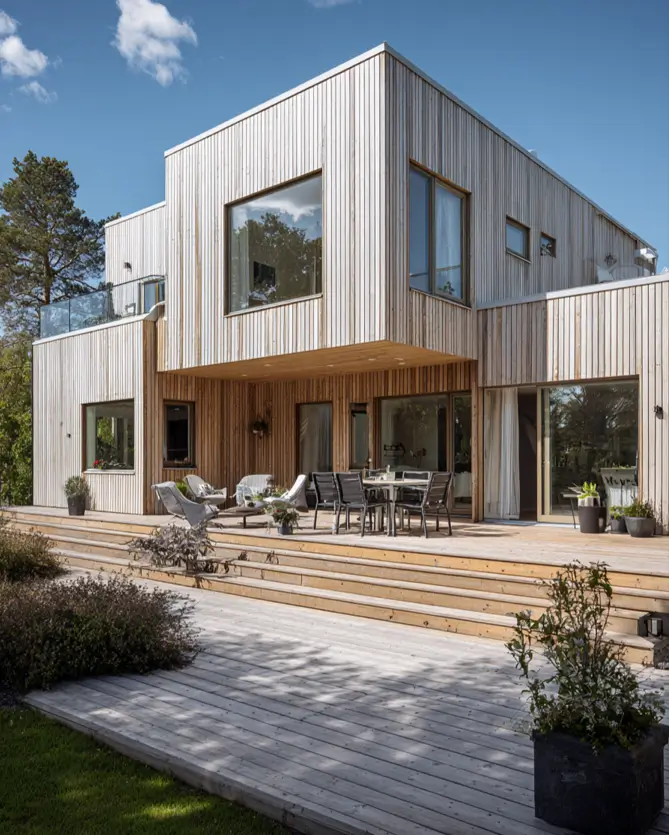
Wrapped entirely in light vertical wood siding, this home uses a tiered wooden deck to add dimension and define distinct outdoor zones for lounging and dining, creating a fluid connection between the home’s various access points and the garden.
12. Create a Winter Retreat
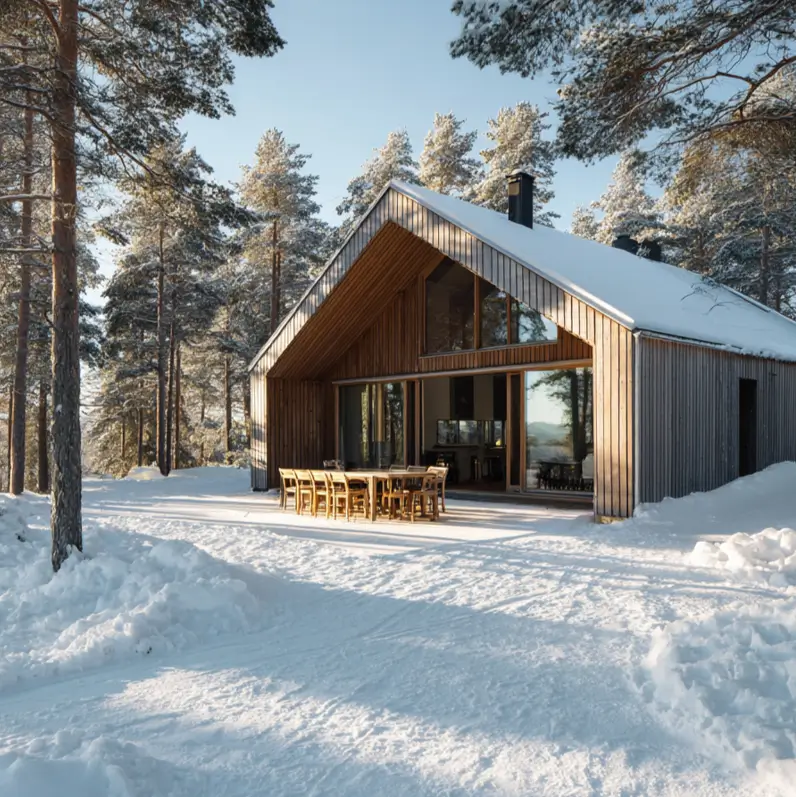
Natural wood siding provides essential warmth against a snowy backdrop, creating a quintessential winter retreat. The deeply recessed gable end of this modern home forms a sheltered patio, offering a seamless connection to the crisp, quiet beauty of the surrounding pine forest. Inside, the same principles help create a tranquil retreat for rest.
13. Shelter a Corner Deck

Natural wood cladding wraps this entire home, creating a warm and inviting presence in the winter landscape. A deep overhang forms a sheltered corner deck, providing a cozy, protected outdoor space that makes the most of the connection to the indoors, even in cooler weather.
14. Maximize Waterfront Views

Dark horizontal siding contrasts with a bright, expansive deck, creating a home designed to embrace its waterside setting. Floor-to-ceiling glass on both levels and a generous balcony maximize the connection to the water, offering stunning, uninterrupted views from nearly every room.
15. Go for a Sprawling Layout
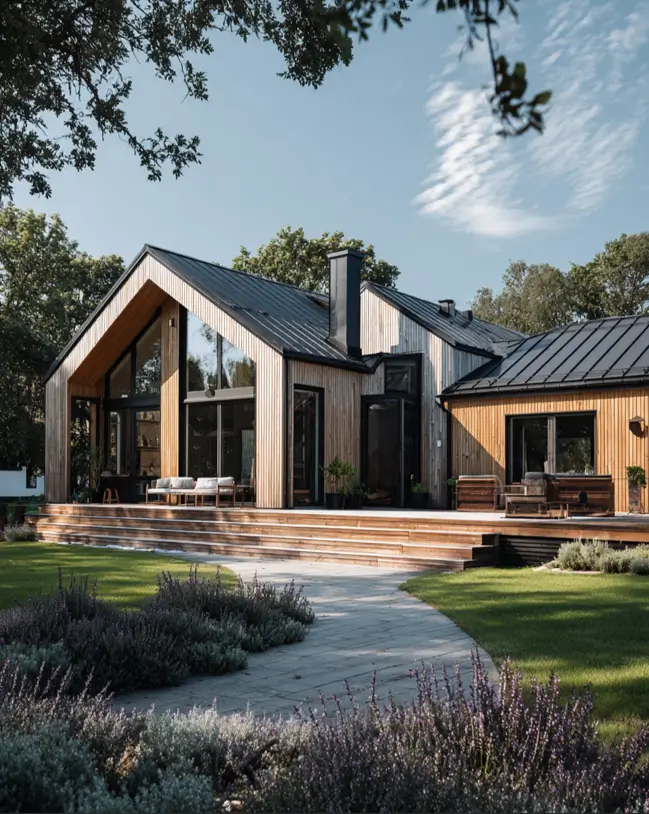
Sprawling single-level designs create an intimate connection with the surrounding landscape. This exterior utilizes a series of interconnected gabled forms, all clad in natural wood, to create a harmonious and expansive home that flows seamlessly into its garden, a design sensibility also found in Japanese Style House Design.
16. Harmonize with Autumn

Light-toned vertical wood siding harmonizes beautifully with the golden hues of autumn foliage. This home, with its clean gable and dark metal roof, sits naturally within the landscape, its simple form allowing the surrounding seasonal colors to take center stage.
17. Create a Coastal Retreat

Natural wood siding weathers beautifully in a coastal environment, blending the home with its seaside setting. This Scandinavian style home exterior, with its expansive deck and floor-to-ceiling glass gable, is perfectly designed for embracing panoramic views and relaxed, indoor-outdoor living.
18. Cast a Warm Winter Glow

Warm interior light transforms a home into a welcoming sanctuary against the cold. This Scandinavian style home exterior, nestled in a snowy forest, uses its large glass facade to cast a soft, inviting glow, highlighting the beauty of its natural wood siding at dusk.
Material & Texture: The Art of Contrast
The beauty of Scandinavian design is often in the details. The thoughtful combination of different materials and textures can elevate a simple form into a work of art. These homes masterfully play with contrast, from smooth to rough and dark to light.
19. Mix Wood and White

Crisp white stucco provides a clean, bright foundation for the warm tones of vertical wood cladding. This popular pairing in Scandinavian design creates a striking visual contrast, adding depth and texture while maintaining a minimalist and welcoming aesthetic.
20. Use a Wood Overhang
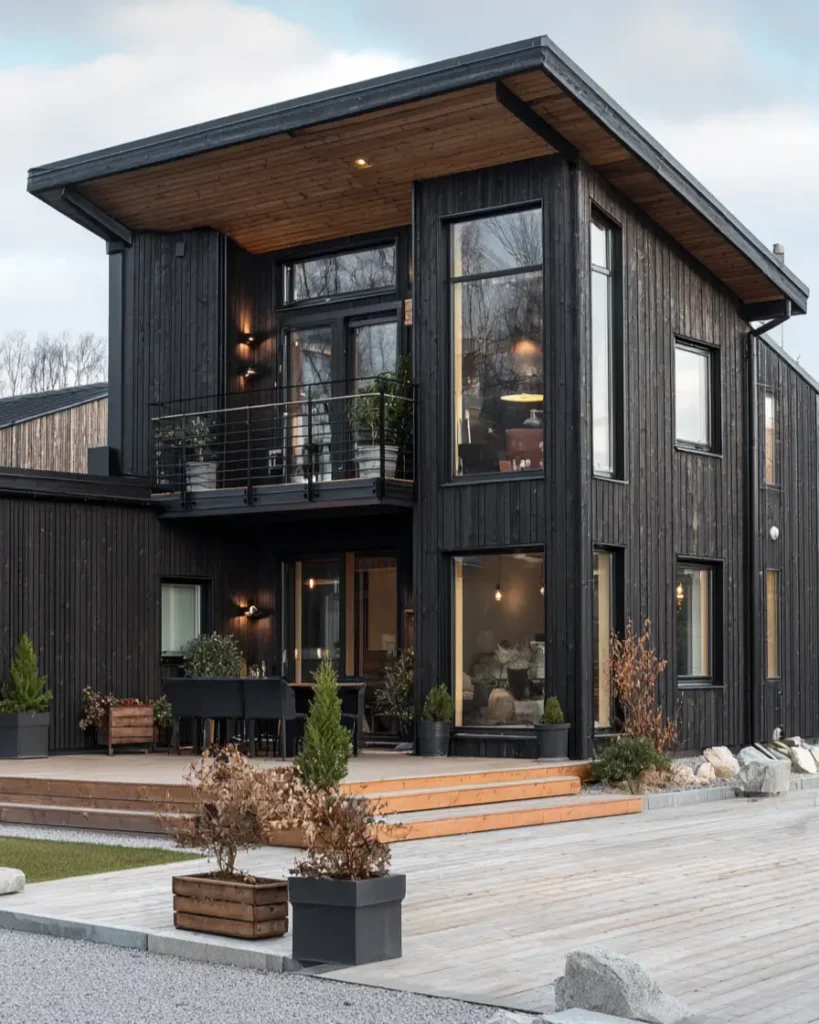
A prominent roof overhang lined with warm-toned wood creates a striking contrast against dark vertical siding. This feature of a Scandinavian style home exterior not only adds architectural depth but also provides a sheltered, inviting space for a balcony or ground-floor patio, blending practicality with design.
21. Contrast Your Materials

High contrast between materials creates a visually engaging exterior. Here, dark black vertical siding wraps around the main structure, while the recessed gable end is highlighted with warm, natural wood, defining the outdoor living spaces on both levels.
22. Combine Stone and Wood
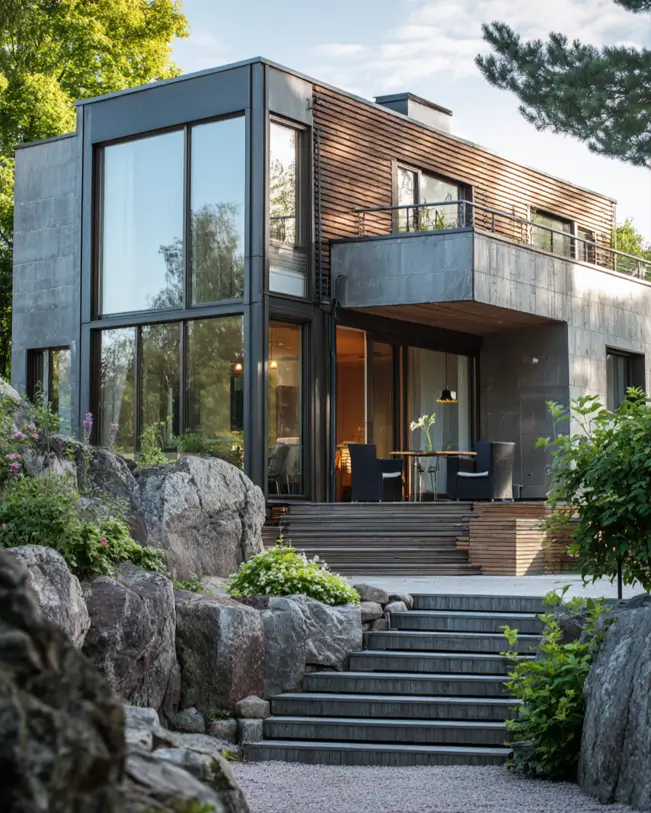
Stone paneling provides a cool, robust counterpoint to the warmth of natural wood siding. This textural contrast adds sophisticated visual interest and grounds the home in its rocky setting, creating a harmonious blend of sleek and natural materials.
23. Wrap Corners in Glass
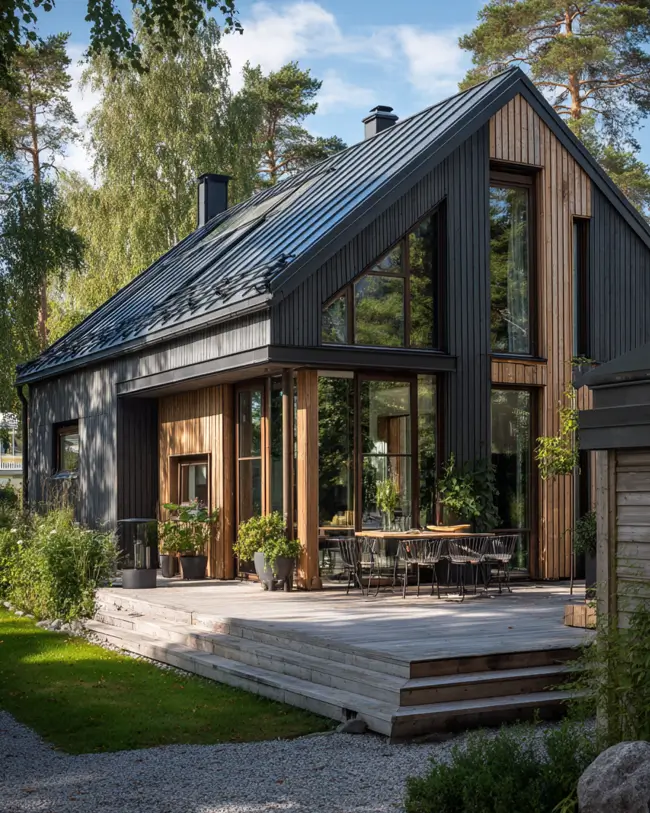
Glass-wrapped corners create a stunning architectural feature, extending the living space toward the outdoors. This home’s exterior uses warm wood frames to contrast beautifully with dark vertical siding, seamlessly connecting the interior to the expansive wooden deck.
24. Layer Different Materials
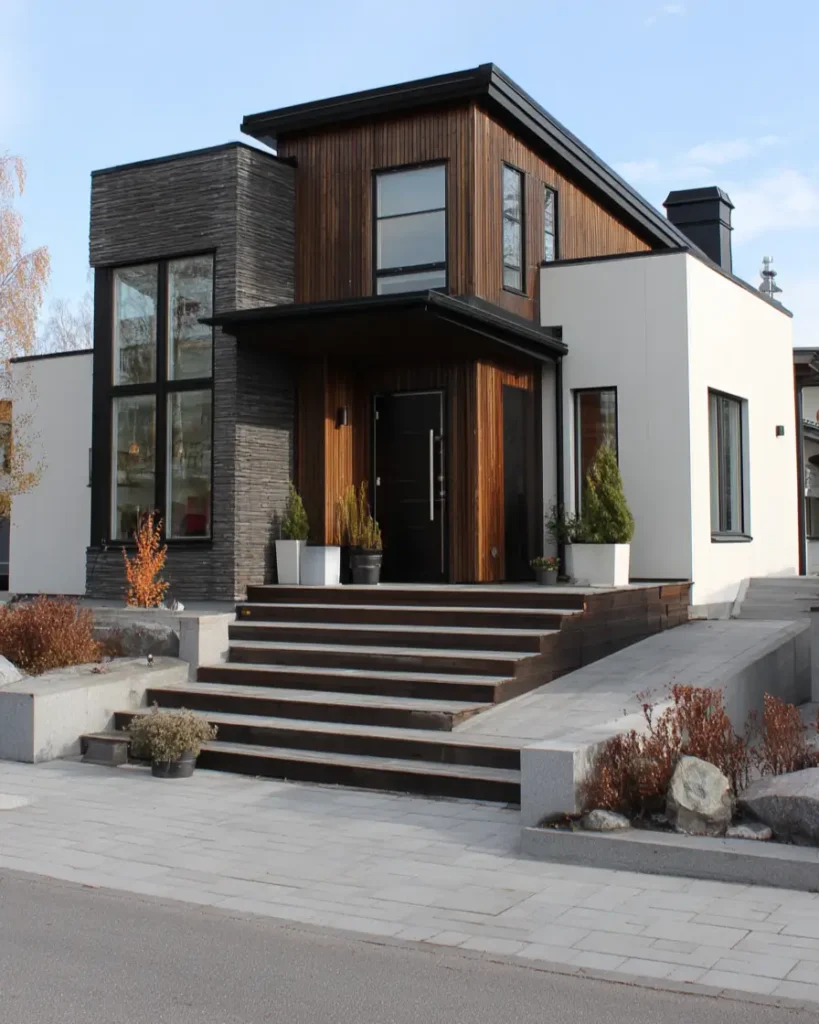
Layering different materials like stacked stone, vertical wood, and smooth white panels adds depth and sophistication. This design uses each material to define distinct architectural volumes, creating a dynamic and visually rich facade that balances texture, color, and clean lines.
25. Try Horizontal Cladding
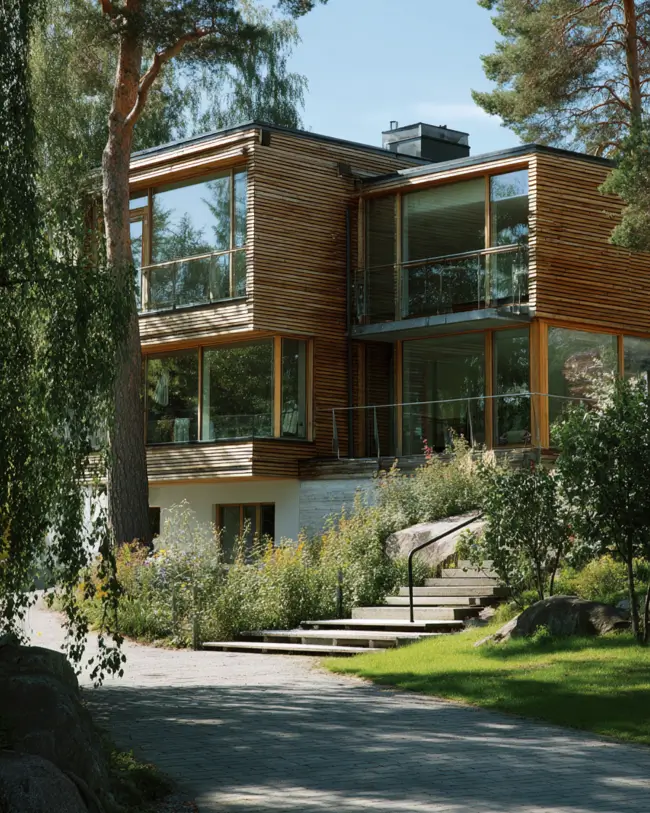
Horizontal wood cladding provides a calm, linear aesthetic that emphasizes the home’s width. This approach, paired with extensive glass walls and balconies, creates a structure that feels both grounded and transparent, fully immersed in its wooded surroundings.
26. Define Zones with Cladding
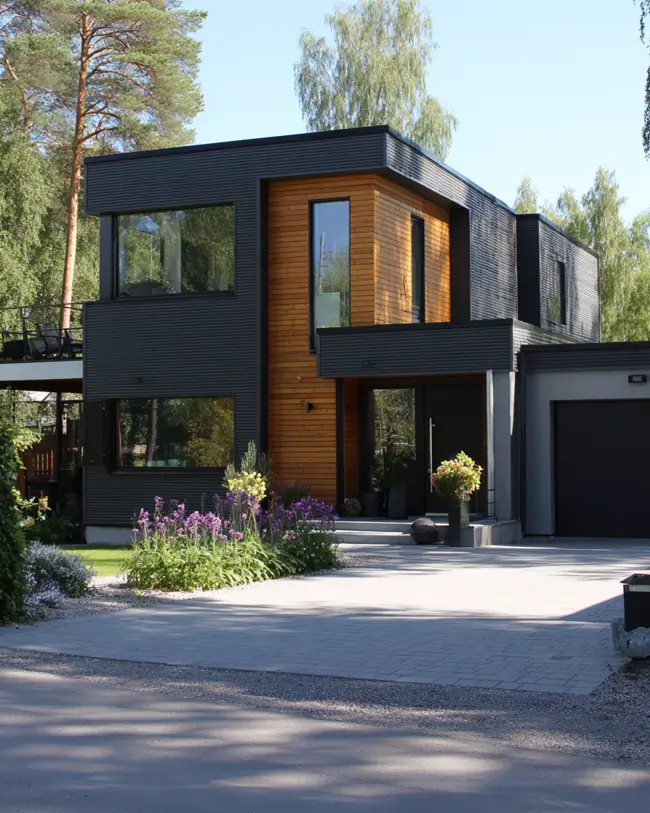
Dark corrugated metal siding provides a modern, industrial frame for the warm, natural wood at the home’s center. This smart use of contrasting materials on an exterior clearly defines the different architectural volumes, creating a sophisticated and balanced composition.
27. Accent Dark Facades with Wood

Rich, warm wood lining the entryway provides a welcoming focal point against a dark, dramatic facade. This design choice on a Scandinavian style home exterior not only adds a touch of natural elegance but also guides the eye, creating an inviting contrast with the moody exterior.
28. Layer Your Textures
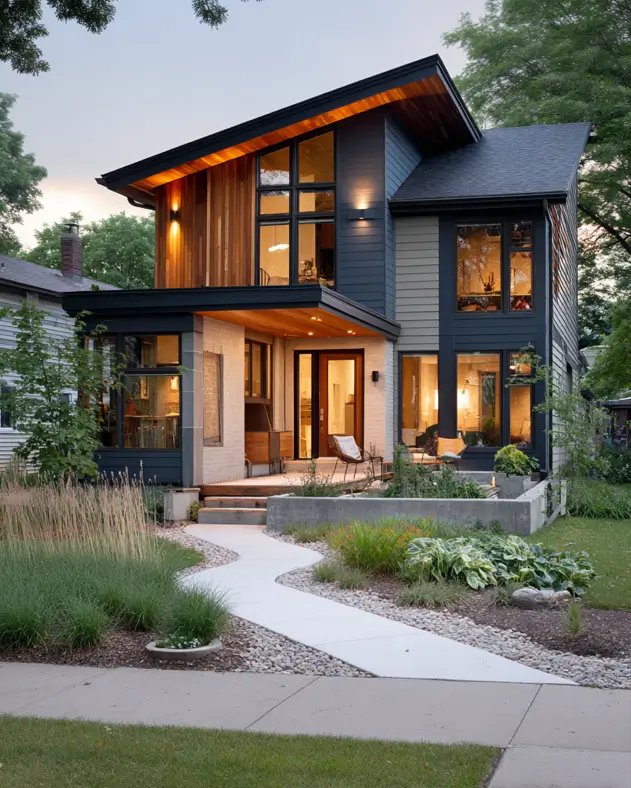
Layering a variety of materials like light stone, dark paneling, and vertical wood siding adds rich textural depth. This home’s design masterfully balances these different elements, using a dynamic roofline and warm lighting to create a cohesive and inviting look.
29. Use Metal Siding

Gray standing seam metal siding provides a sleek, durable, and low-maintenance finish. On this modern Scandinavian exterior, the cool-toned metal is beautifully contrasted by recessed sections of warm wood, creating depth and highlighting the home’s multi-level balconies and entryway.
30. Install Stone Panels
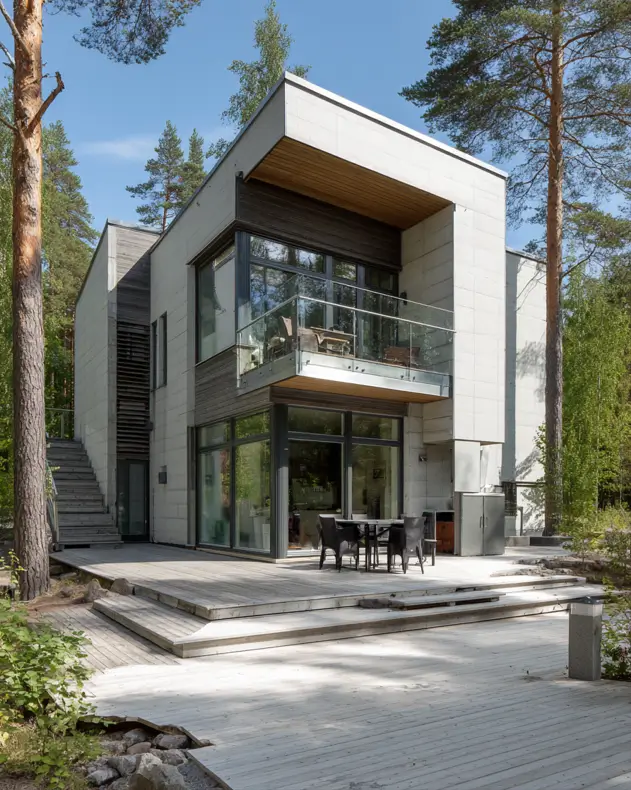
Large, smooth stone panels offer a sleek and sophisticated alternative to traditional siding. This modern Scandinavian exterior balances the cool elegance of the stone with warm wood accents lining the overhang and a weathered wooden deck that blends into the surrounding nature.
Bold Statements: Dramatic Architectural Forms
While rooted in tradition, modern Scandinavian design is always evolving. These exteriors showcase a more dramatic and contemporary side of the style, using dark palettes, dynamic rooflines, and bold forms to make a statement.
31. Choose Black Cladding
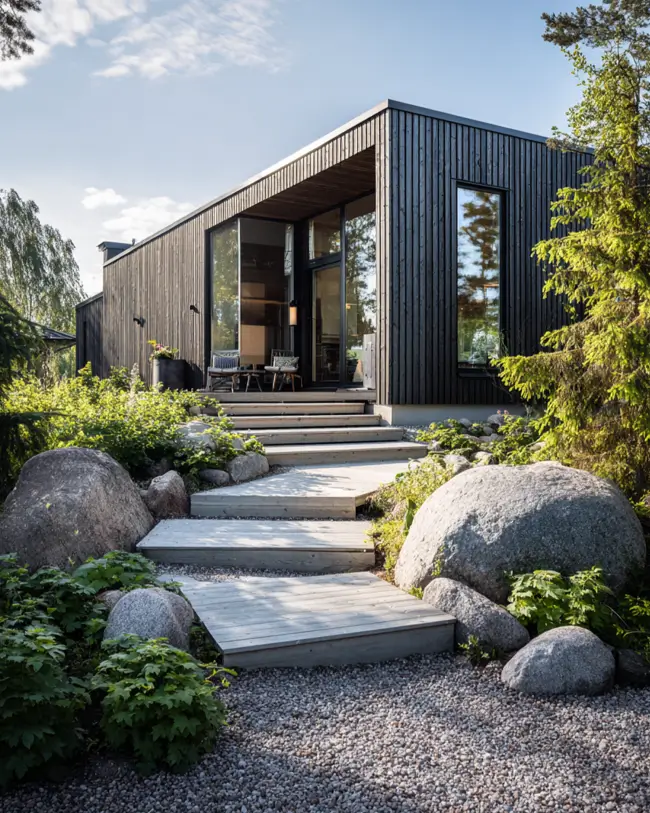
Dark-stained vertical siding offers a sophisticated and dramatic alternative to natural wood tones. This bold choice, popular for modern black exterior houses, creates a striking profile that recedes beautifully into a lush, natural backdrop, allowing the landscape and architectural lines to stand out.
32. Use Geometric Shapes
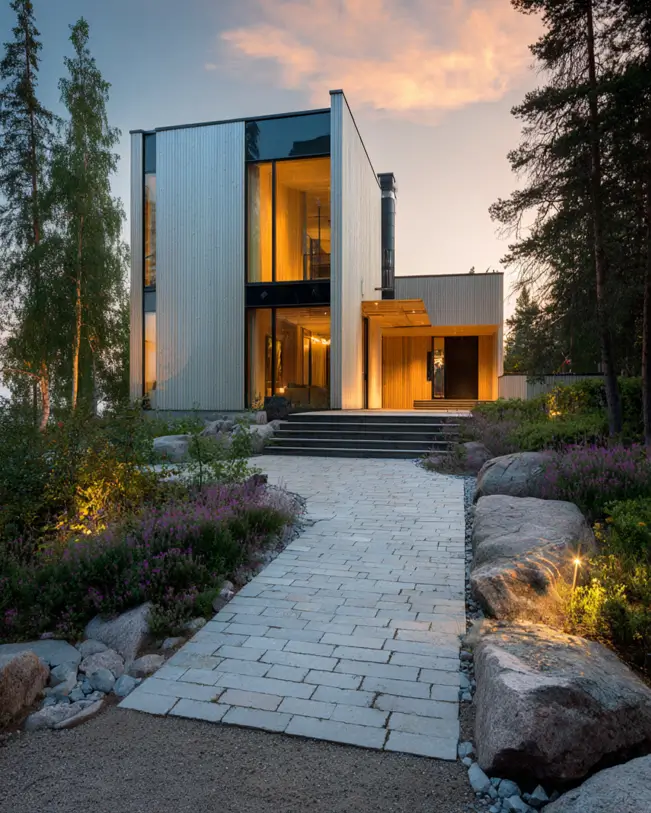
Geometric volumes create a striking silhouette against the natural landscape. This Scandinavian style home exterior features light wood cladding and floor-to-ceiling windows, which add visual interest and flood the interiors with warm, ambient light, blurring the lines between indoors and out.
33. Design a Dynamic Roofline
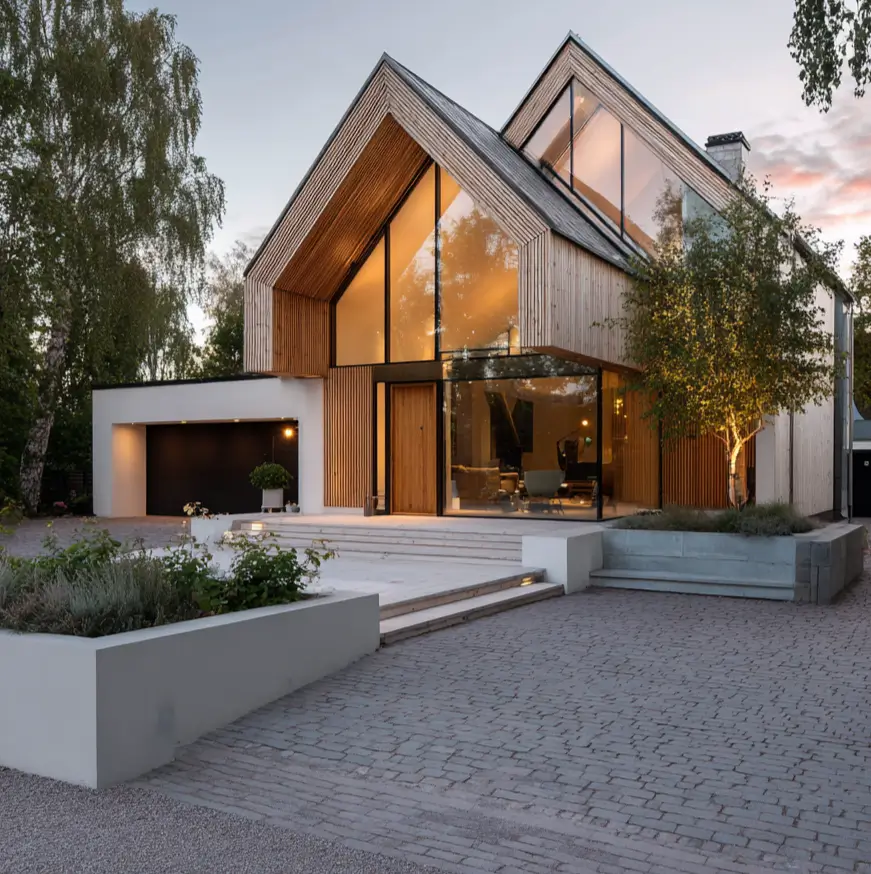
Multiple gables and varied roof heights create a visually dynamic and sculptural form. In this home, light wood cladding flows seamlessly across the walls and up to the rooflines, while curved and geometric glass walls open the home to the evening light.
34. Try a Cubist Form

Block-like volumes create a strong architectural statement in this Scandinavian style home exterior. Clean white surfaces are punctuated by sections of warm wood siding and large windows, offering a balanced composition. The glowing interior provides a welcoming contrast to the cool, snowy landscape.
35. Use an Asymmetrical Roof
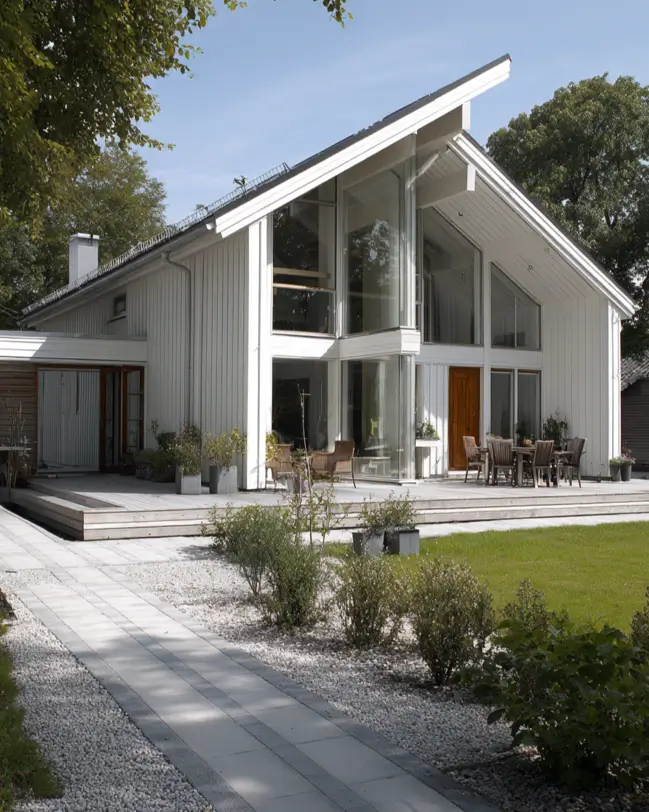
White vertical siding offers a fresh and classic take on a home’s exterior. An asymmetrical roofline adds a contemporary twist to the traditional gable form, while floor-to-ceiling glass creates an airy, light-filled connection between the home and the expansive wooden deck.
36. Elevate the Entryway

Wide stone staircases make a powerful statement, leading up to the dark, sculptural form of this home. Black vertical siding creates a dramatic profile against the foliage, while a stone base connects the structure to its rocky foundation, embodying a key modern Scandinavian exterior principle.
37. Add a Textured Finish

Textured black siding gives this Scandinavian style home exterior a rustic yet modern feel. The rough finish of the wood contrasts with the smooth metal on the roof and upper volume, while a wood-lined entryway adds a touch of warmth to the otherwise monochromatic facade.
38. Choose a White Facade
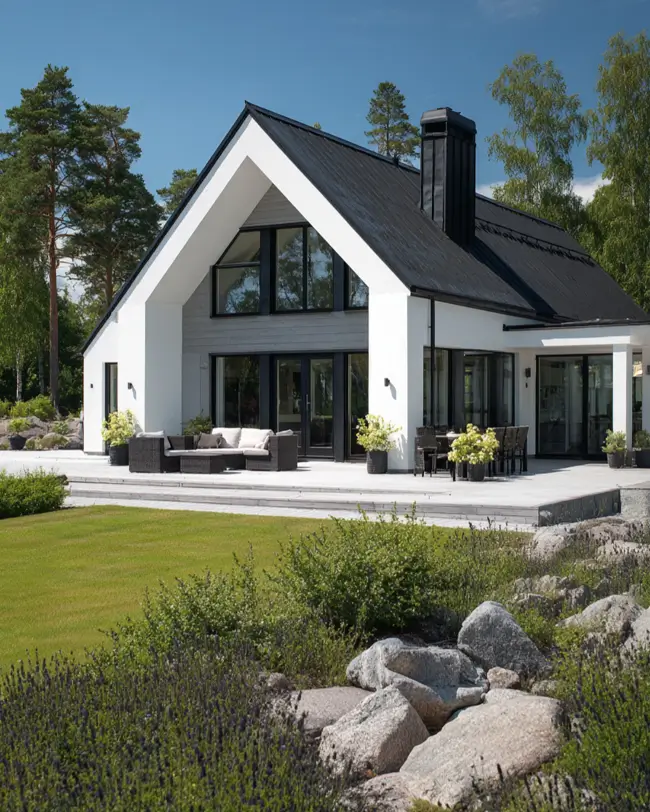
Crisp white stucco creates a bold statement against a black roof and dark window frames. A design like this uses high contrast to emphasize its clean lines and strong gable silhouette, resulting in a graphic and timelessly modern aesthetic.
39. Light Up the Entrance
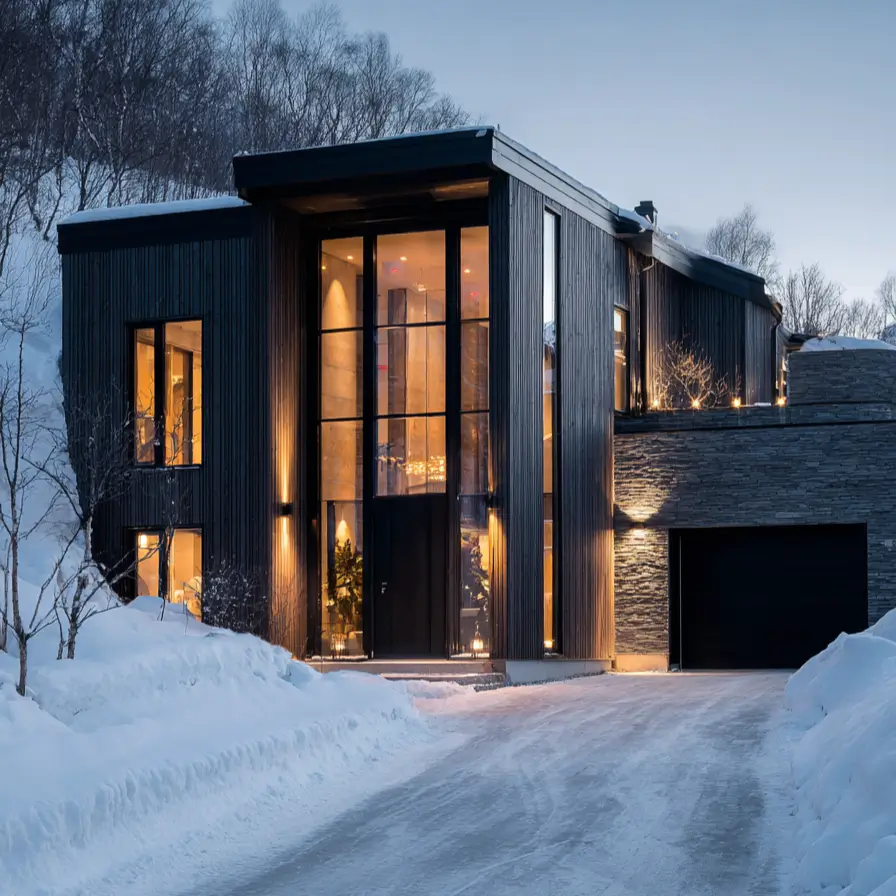
Towering glass entryways act as a luminous beacon in the winter twilight. This exterior contrasts dark wood and stone with a brightly lit, two-story glass facade, revealing the warmth of the interior and creating a stunningly dramatic sense of arrival.
40. Add a Cantilever

Cantilevered volumes create a striking, gravity-defying effect, adding a layer of architectural drama. This design uses a projecting upper level to create visual interest and a sheltered space below, while warm lighting emphasizes its clean, geometric lines against the forest.
41. Use Angled Rooflines
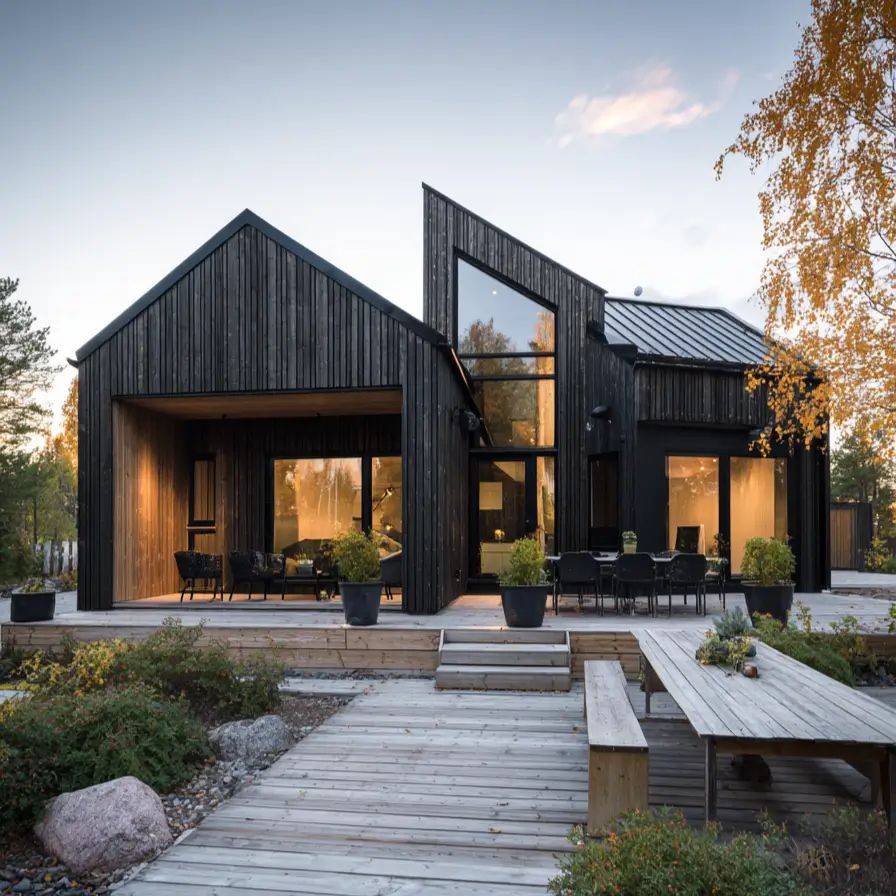
Sharp, angular rooflines that move in different directions create a dynamic and sculptural silhouette. This design gives the dark exterior a sense of movement and visual complexity, with strategically placed windows capturing light from multiple angles throughout the day.
42. Design an Asymmetrical Facade
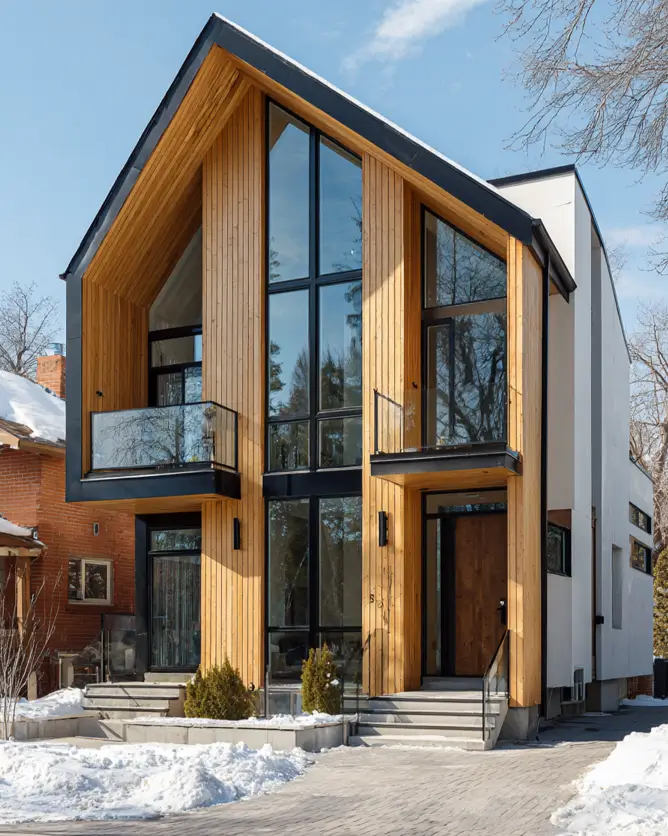
Natural wood cladding on the recessed front facade creates a warm, inviting contrast with the crisp white side wall. A modern Scandinavian house exterior with this design plays with asymmetry, using a steeply pitched roof and prominent black trim to create a visually dynamic first impression.
43. Use a Slanted Roof
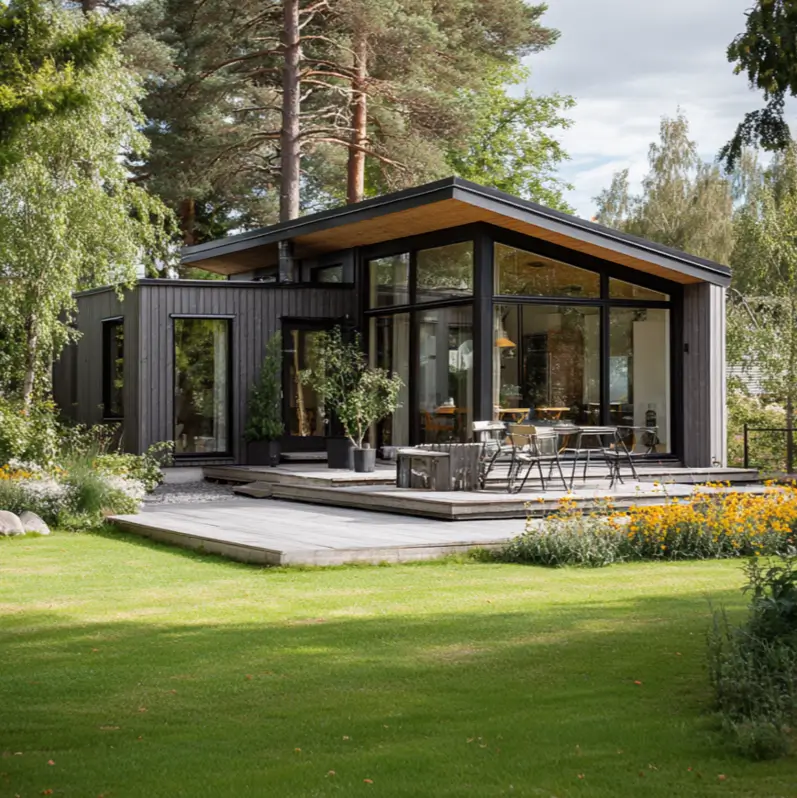
Slanted rooflines offer a modern, dynamic alternative to traditional gables. This design, seen on the dark exterior, extends to form a generous overhang, creating a sheltered patio space. Floor-to-ceiling windows ensure the interior remains connected to the verdant lawn.
44. Go for a Two-Tone Look

Color blocking with a warm, orange-toned wood on the lower level and sleek black on the upper creates a bold, graphic statement. This exterior uses the sharp contrast to highlight its unique architectural form, including the distinctive dormer and angled windows.
Versatile Designs: Modern & Blended Styles
The versatility of Scandinavian design allows it to blend with other styles and adapt to different contexts, from large family homes to compact living solutions. These examples showcase the flexibility and enduring appeal of the aesthetic.
45. Build on Multiple Levels

Multiple levels and projecting balconies add dynamic interest to this modern Scandinavian exterior. The clean, white vertical paneling enhances the home’s height and reflects natural light, while large windows on each floor ensure a strong connection between the living spaces and the surrounding garden.
46. Use Interlocking Volumes
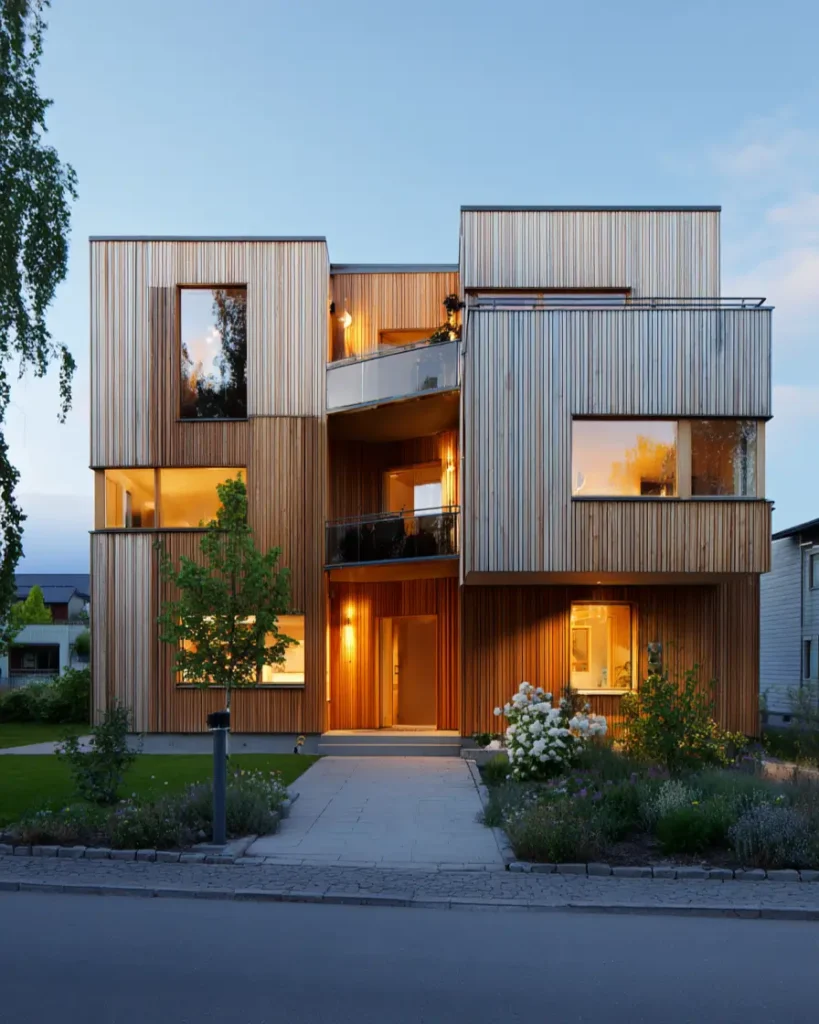
Interlocking geometric volumes give this exterior a dynamic, puzzle-like quality. Natural wood cladding unifies the complex form, wrapping around each distinct section. Thoughtfully placed windows and recessed balconies create private nooks and ensure each space is filled with light.
47. Include a Projecting Balcony
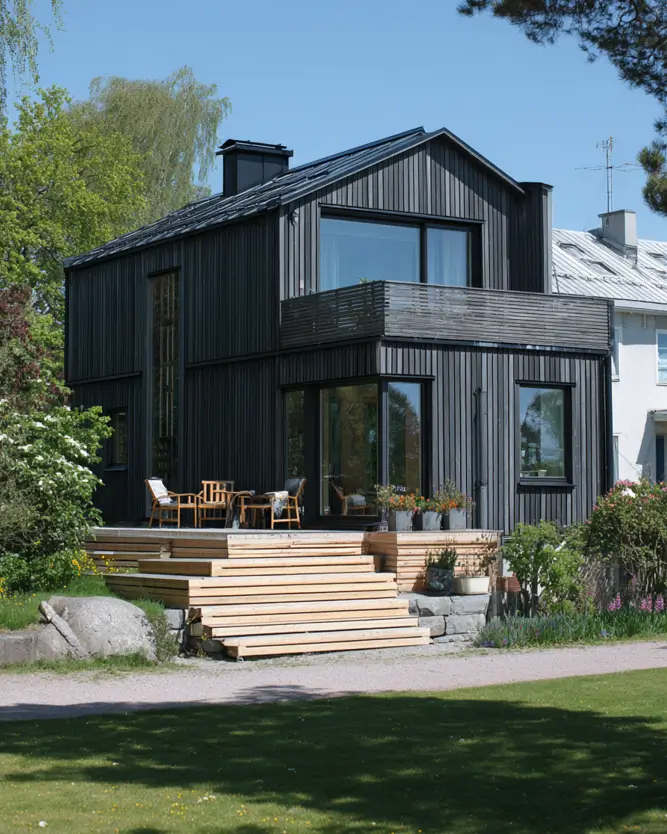
Dark vertical siding creates a sleek, monolithic form for this exterior. Projecting elements, like the second-floor balcony, add architectural depth and provide a private outdoor retreat, while a raw wood deck offers a rustic, textural contrast below.
48. Mix Old and New Forms

Combining a traditional barn-like silhouette with a a modern, flat-roofed extension creates a dynamic, multi-part structure. This design uses light wood siding to unify the different sections, while a dark metal roof adds a sleek, contemporary finish to the classic gable.
49. Enclose a Porch in Glass

Glass-enclosed porches and balconies update a traditional farmhouse silhouette with modern functionality. This design choice floods the interior with light and creates year-round living spaces that feel connected to the outdoors, blending classic white vertical siding with contemporary transparency.
50. Mix Farmhouse and Modern
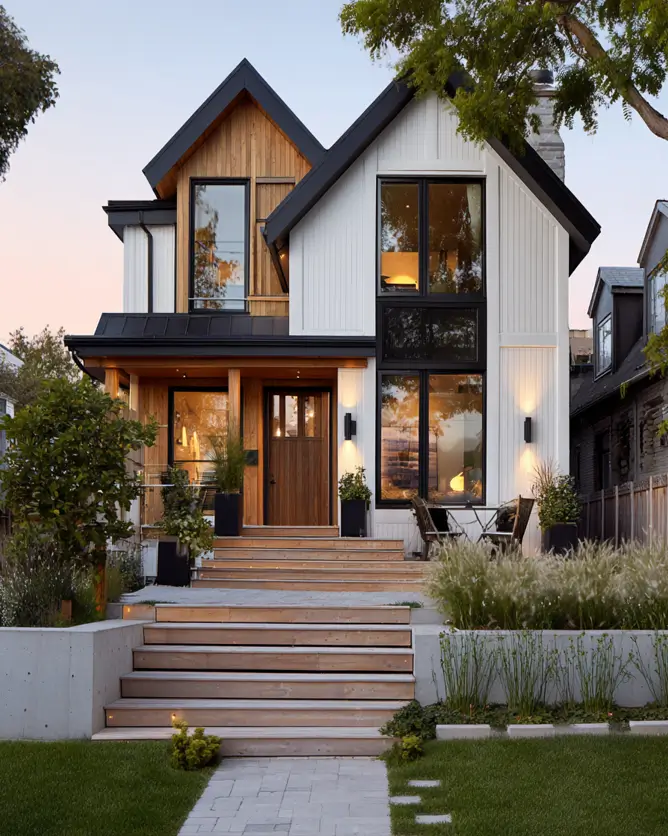
White board-and-batten siding creates a classic farmhouse feel, given a modern edge with black window frames and roofing. This popular modern Scandinavian exterior blends styles by using natural wood accents on the upper gable and porch to add warmth and textural variety.
51. Elevate the Living Space
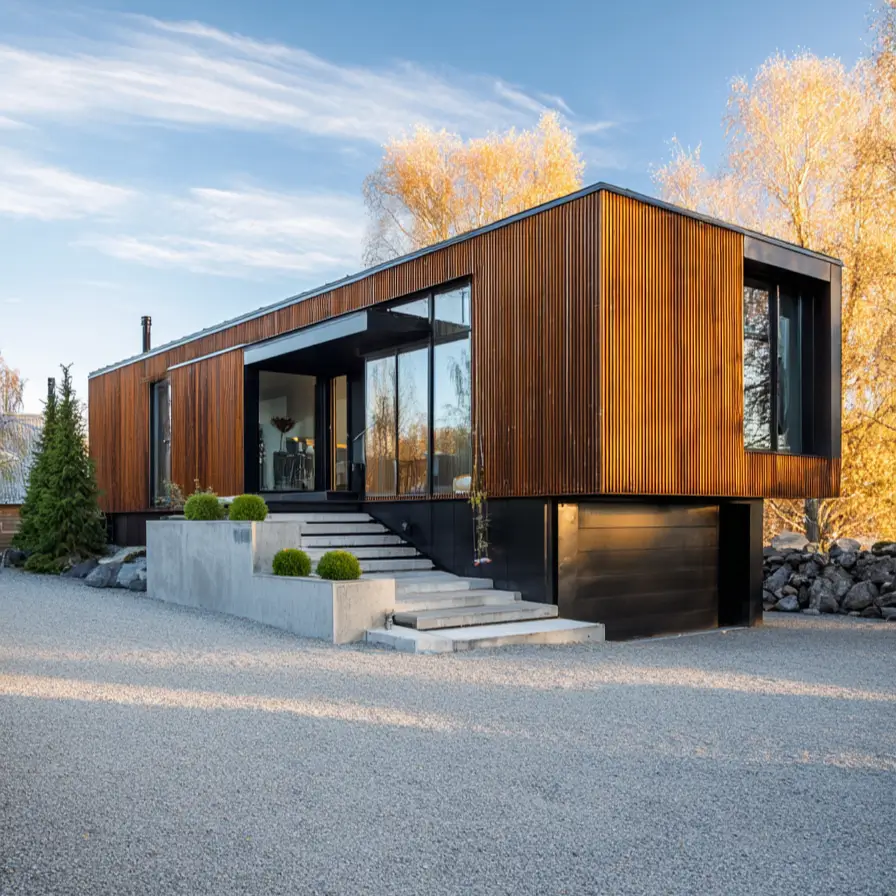
Elevating the primary living area above the garage creates a distinct separation of space and enhances views. This home’s design uses a concrete base to ground the structure, allowing the warm, wood-clad upper level to feel light and airy against the autumn sky.
52. Use Multiple Gables
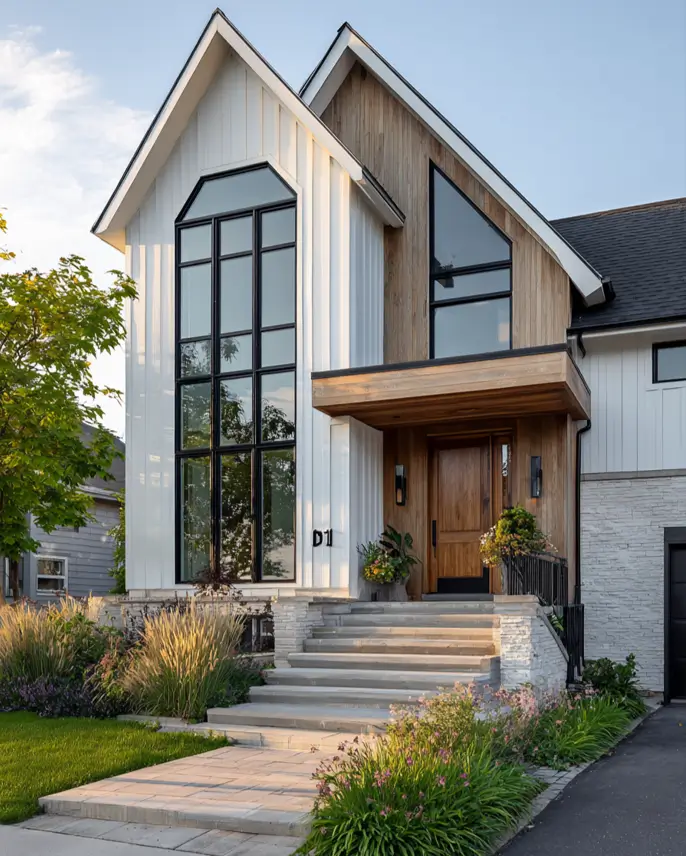
Multiple gables of varying sizes create an interesting, layered roofline. This exterior elegantly combines crisp white siding with the warmth of natural wood and a light stone base, while a tall arched window adds a touch of classic grandeur to the facade.
53. Adapt for Compact Living

Scandinavian design principles scale down beautifully for compact living. This tiny home showcases light wood cladding and a large glass wall, maximizing natural light and a sense of space without sacrificing the clean lines and connection to nature central to the aesthetic.
54. Get the Modern Farmhouse Look
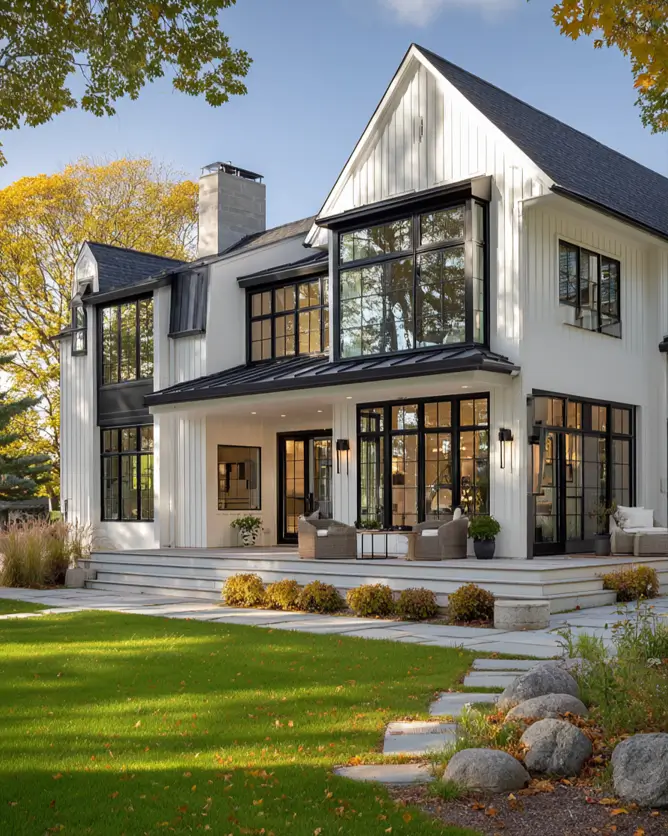
White vertical siding and prominent gables provide a classic farmhouse foundation for this elegant home. The modern Scandinavian influence is clear in the bold, black-framed windows that add a graphic quality and the seamless connection to the outdoor patio, perfect for relaxed family living.
A Style Defined by Simplicity and Soul
More than just an architectural style, the modern Scandinavian house exterior is a philosophy. It prioritizes light, honors natural materials, and finds beauty in functional, uncluttered design. At its heart, Nordic design creates a home that is warm, welcoming, and deeply connected to its environment. We hope these examples have inspired you to bring a touch of Scandinavian simplicity and soul to your own home.
Frequently Asked Questions
What are the key features of a modern Scandinavian house exterior?
A modern Scandinavian house exterior is defined by its minimalist aesthetic, clean lines, and strong connection to nature. Key features of this Nordic architecture include the prominent use of natural materials like wood, large windows to maximize light, simple forms like gabled roofs, and neutral color schemes.
What materials are commonly used for a Scandinavian style home exterior?
The most common material is wood, prized for its natural warmth. This is often paired with durable materials like standing-seam metal for roofing, natural stone for foundations or accents, and large panes of glass. Crisp white stucco or render is also popular for creating a clean, bright contrast.
How can I make my house exterior look more Scandinavian?
To introduce a modern Scandinavian house exterior look, start by simplifying the color palette to neutrals like white, gray, and black. Consider adding architectural details like vertical wood cladding as an accent. Upgrading to larger windows with simple, dark frames and focusing on uncluttered landscaping can also make a significant impact.


